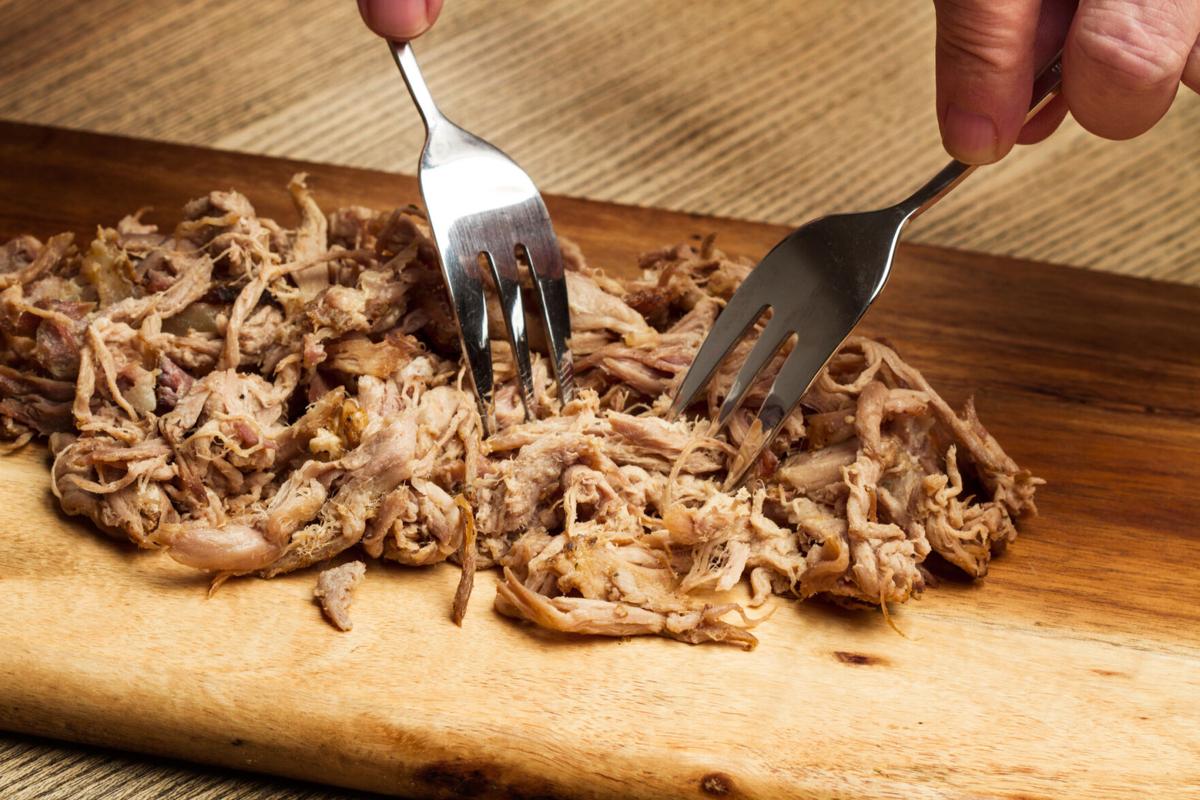My plan was to make carnitas, the shredded pork that’s so versatile as a filling, because I like to have some tucked away in the fridge or freezer for quick dinners. But along the way, I got diverted to something else.
As I was shredding the pork in my stand mixer, I realized that it looked an awful lot like the pork rillettes that I love. The French classic is just the ticket for a small snack to accompany drinks before dinner – they’re satisfyingly rich so you don’t need much, but they’ll keep body and soul together while you wait for dinner to be done.
(I’m such a lazy cook that shredding meat with two forks is just too much work, so I almost always use my stand mixer, fitted with the paddle attachment, to do the job for me. It works for everything from beef to chicken to pork. Use the slowest speed so you don’t turn the meat into paste.)
And that’s how my carnitas turned into Southwestern rillettes.
Once the meat was nicely shredded and cooled, I moistened it with a little of the cooking liquid and packed it into two pint-sized canning jars. I set the lids on them loosely and refrigerated them along with the cooking liquid.
After an hour or so, the fat had risen on the cooking liquid and was easy to skim off. I discarded the rest of the cooking liquid and melted the fat. Then I poured it over the shredded meat in the jars, refitted the lids, and stashed it in the refrigerator for later enjoyment.
A couple of notes about this recipe:
Three tablespoons seems like an insane amount of chile powder. It’s not, really. While you really want its flavor to permeate the pork, most of it will remain in the cooking liquid, which you’ll discard. You could substitute any combination of fresh or dried chiles for the chile powder – anchos, chipotles and jalapeños or serranos would be good. I still have a pint of hot red chile powder from San Xavier Co-op, so I used that. I like this a little bit zippy from the chiles, but you should suit your own palate.
A tablespoon of salt also seems like a lot. But it’s not there for flavor – it’s to create a light brine that helps the pork pick up the flavors of the seasonings.
I wanted the fresh, grassy flavor of cilantro but knew that the herb version would lose all its punch in the long cooking. Using coriander seed, lightly crushed, accomplished the same effect – not surprising, since cilantro is called coriander in much of the world.
If I’d had a couple of limes on hand, I would have squeezed them over the shredded meat before moistening it with the cooking liquid. The lime juice’s flavor will intensify as the meat stands in the refrigerator.
Southwestern rillettes
Makes about 8 servings
When the French makes rillettes, they pour some of the remaining melted fat over the top of the rillettes after packing them into crocks or jars. It helps the rillettes keep longer; just scrape the fat off before serving. Without the fat, these will keep a week or longer in the refrigerator; with the fat, they’ll keep several weeks longer.
2 to 2½ pounds fatty boneless pork shoulder, cut into chunks
3 garlic cloves, smashed and peeled
1 large onion, coarsely chopped
3 tablespoons chile powder
1 tablespoon coriander seeds, crushed, optional
1 tablespoon salt
1 tablespoon cumin
2 cups chicken stock or broth (or 1 14-ounce can)
Preparation
In a large, lidded Dutch oven, place all ingredients. Cover and bring to a boil over medium-high heat. Reduce heat to low and simmer until the pork is falling apart, about three hours. Or make this in your electric pressure cooker: Place all ingredients into the pot, cover and cook on high pressure for 45 minutes. When the time is up, turn off the pressure cooker and allow pressure to release naturally.
When the meat is done, transfer it to a large bowl or stand mixer. Shred the meat with two forks or, in the stand mixer, use the paddle attachment on low speed to shred the meat. Set aside.
Strain the cooking liquid into a large glass measuring cup and refrigerate for an hour or two so the fat can rise. Skim off the fat and remelt on low heat. Use some of the remaining cooking liquid to moisten the shredded meat – not so much that it’s soupy. Discard remaining cooking liquid. Pack the shredded meat into one or two clean lidded glass jars, making sure there are no air pockets. Smooth the tops and pour some of the reserved fat over the meat to cover. Add the lids and refrigerate.
At serving time, use a spoon to remove the top layer of fat. Serve as a spread for slices of French bread, or as a dip with tortilla chips.





